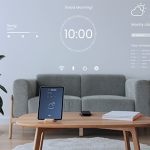Smart Homes 101: Integrating Home Automation for Energy Efficiency
In an era where technology seamlessly integrates into our daily lives, the concept of smart homes has transitioned from a futuristic idea to a practical solution for modern living. Smart homes, equipped with home automation systems, are at the forefront of this evolution, offering unparalleled convenience and, importantly, a pathway to greater energy efficiency. As we become increasingly conscious of our environmental footprint and the need for sustainable living, the relevance of smart homes has never been more pronounced.
At Voltfix Electrical, we understand the significance of this transition. While our expertise lies in providing top-notch electrical solutions, we take pride in our role as enablers of smart home technologies that prioritise energy efficiency. Our commitment is not just to power homes but to empower them to be more energy-smart, aligning with the needs of a rapidly evolving world.
Understanding Smart Homes and Home Automation
The term ‘smart home’ refers to a residence equipped with a series of interconnected devices and appliances that can be remotely controlled, automated, and optimised for efficiency. Home automation is the backbone of this concept, where technology is employed to automate daily tasks traditionally done by humans. This automation ranges from simple tasks like controlling lights and thermostats to more complex systems like security and entertainment controls.
The journey towards smart technology in homes has been evolutionary. Initially, home automation was a luxury, accessible only to those who could afford the sophisticated technology. However, with advancements in technology and the advent of the Internet of Things (IoT), smart homes have become more accessible and affordable. IoT plays a pivotal role in this landscape, as it allows devices within the home to communicate with each other via the internet, creating an ecosystem that learns and adapts to the homeowner’s lifestyle, enhancing both convenience and energy efficiency.
The Link Between Home Automation and Energy Efficiency
The integration of home automation in smart homes is not just a step towards modern living; it’s a leap towards energy efficiency. Smart home technology is ingeniously designed to optimise energy usage, thereby contributing significantly to both environmental and economic benefits.
At the heart of this efficiency is the ability of smart home systems to learn and adapt to the homeowner’s lifestyle. For instance, smart thermostats can adjust heating and cooling based on when the house is occupied or empty, reducing unnecessary energy consumption. Similarly, smart lighting systems can automatically dim or turn off lights in unoccupied rooms. These automated actions, while seemingly small, accumulate substantial energy savings over time.
The environmental benefits of energy-efficient homes are profound. By reducing energy consumption, smart homes directly contribute to the reduction of greenhouse gas emissions. This is crucial in the fight against climate change, as residential energy use is a significant contributor to global carbon emissions. Economically, the advantages are equally compelling. Energy-efficient homes can lead to significant reductions in utility bills. This not only makes smart homes a cost-effective choice but also adds to their market value, making them a wise investment for the future.
Supporting these claims are numerous studies and statistics that highlight the energy-saving potential of smart homes. For instance, research indicates that smart thermostats alone can save up to 10-12% on heating and 15% on cooling, amounting to annual savings on utility bills. Another study suggests that smart lighting can reduce energy consumption by up to 45% through dimming and other energy-saving features. These figures not only underscore the potential of smart homes in energy conservation but also highlight their role in paving the way for a more sustainable and economically viable future.
Key Components of a Smart Home for Energy Efficiency
In the realm of smart homes, certain components stand out for their significant contributions to energy efficiency. These elements not only streamline home management but also play a pivotal role in reducing energy consumption and costs.
Smart Thermostats: A cornerstone of energy-efficient smart homes, smart thermostats go beyond basic temperature control. They learn the homeowner’s schedule and preferences, making automatic adjustments to heating and cooling systems. This intelligent management ensures that energy is not wasted heating or cooling an empty home. Moreover, many smart thermostats provide detailed energy usage reports, allowing homeowners to make informed decisions about their consumption patterns.
Intelligent Lighting Systems: Lighting is a fundamental aspect of any home, but it also represents a significant portion of energy use. Intelligent lighting systems address this by allowing homeowners to control lighting remotely, set schedules, and even adjust brightness based on natural light availability. These systems can significantly reduce energy consumption by ensuring lights are only used when needed and are operating at optimal levels for both comfort and efficiency.
Smart Plugs and Appliances: Smart plugs and appliances bring the concept of energy management to every corner of the home. By connecting ordinary appliances to smart plugs, homeowners can monitor and control their operation remotely. This not only includes turning devices off when they’re not in use but also setting them to operate at times when energy rates are lower. Smart appliances, such as refrigerators and washing machines, have built-in features to optimise their energy use without compromising performance.
Energy Monitoring Systems: Knowledge is power, especially when it comes to energy consumption. Energy monitoring systems provide real-time data on how much energy is being used in the home. This transparency allows homeowners to identify high-energy activities and appliances, and make adjustments to reduce consumption. These systems can be instrumental in developing a more energy-conscious lifestyle and making more informed decisions about energy use.
Integration and Control
The true power of a smart home lies in the seamless integration of various smart devices, working in harmony to achieve optimal energy efficiency. This integration is key to transforming individual smart components into a cohesive, energy-efficient system.
Integration of Different Smart Devices: The integration of smart devices such as thermostats, lighting systems, plugs, and appliances allows for a comprehensive approach to energy management. When these devices communicate and work together, they can make intelligent decisions based on overall energy usage patterns. For example, a smart thermostat can adjust the heating or cooling based on whether the smart lighting system indicates anyone is home. This level of integration ensures that energy is not just saved in isolation but optimised across the entire home.
User-Friendly Interfaces and Control Systems: The effectiveness of a smart home system is greatly enhanced by user-friendly interfaces and controls. These systems should be intuitive, allowing homeowners to easily monitor and adjust settings as needed. Whether it’s through a smartphone app, a central control panel, or voice commands, the ability to effortlessly control and customise the settings of various smart devices is crucial. This ease of use not only encourages interaction with the system but also ensures that homeowners can quickly adapt settings to suit their immediate needs, further enhancing energy efficiency.
Practical Steps to Convert Your Home into a Smart Home
Transforming your home into a smart home is a journey towards convenience, security, and significant energy savings. Here’s a step-by-step guide to start with home automation, focusing on energy efficiency:
- Assess Your Needs: Begin by evaluating which aspects of your home could benefit most from automation. Consider areas where energy is used extensively, such as heating, cooling, and lighting.
- Start with a Smart Thermostat: A smart thermostat is often the best starting point for energy efficiency. It controls a significant portion of your home’s energy consumption and offers immediate benefits in terms of cost and energy savings.
- Add Smart Lighting: Invest in smart lighting solutions, such as LED bulbs and intelligent lighting controls. These systems can adapt to your lifestyle, reducing energy consumption by turning off lights in unoccupied rooms or adjusting brightness based on the time of day.
- Choose Smart Plugs and Appliances: Smart plugs can make any appliance more energy-efficient by allowing you to control them remotely and set schedules. When purchasing new appliances, look for smart, energy-efficient models.
- Install Energy Monitoring Systems: To keep track of your energy savings and consumption, consider adding an energy monitoring system. This will help you understand your energy usage patterns and identify further opportunities for savings.
- Expand Gradually: Home automation doesn’t have to be an all-or-nothing approach. Expand your system gradually, adding new devices and functionalities as you become more comfortable and as your budget allows.
- Selecting the Right Products: When choosing smart home products, look for compatibility with existing devices and ease of use. Prioritise products with proven energy-saving features and positive customer reviews.
- Professional Consultation and Installation: For a seamless transition, professional guidance is invaluable. This is where Voltfix Electrical can assist. While our promotional content is minimal, it’s important to note that our expertise in smart home solutions makes us a reliable partner in your smart home journey. We can help you select the right products, ensure they are integrated correctly, and provide advice on maximising energy efficiency.
By following these steps and seeking expert assistance when needed, you can effectively convert your home into a smart, energy-efficient space. Remember, the transition to a smart home is not just about technology; it’s about creating a more sustainable, efficient, and comfortable living environment.
Challenges and Considerations
Adopting smart home technology, while beneficial, comes with its own set of challenges and considerations. Being aware of these can help in making informed decisions and ensuring a smooth transition to a smart, energy-efficient home.
- Cost Concerns: One of the primary challenges in adopting smart home technology is the initial cost. High-quality smart devices and systems can be a significant investment. However, it’s important to consider the long-term energy savings and increased home value that these technologies offer. Over time, the reduction in energy bills often offsets the initial expense.
- Privacy and Security: With the increasing connectivity of smart home devices, privacy and security concerns are valid. It’s crucial to choose devices with robust security features and regularly update their software to protect against potential cyber threats. Homeowners should also be aware of the data collected by these devices and understand how it’s used and stored.
- Technology Compatibility: Ensuring that different smart home devices are compatible and can work seamlessly together is another challenge. Opt for devices that support standard communication protocols and are known for their interoperability.
- Complexity and Usability: The complexity of installing and using smart home systems can be daunting for some. Selecting user-friendly devices and systems is key. It’s also beneficial to start small and gradually add more devices as you become comfortable with the technology.
- Choosing the Right Service Provider: The installation and maintenance of smart home systems require expertise. Choosing the right service provider is crucial for a hassle-free experience. A reliable service provider not only offers quality installation but also provides ongoing support and maintenance. This is where Voltfix Electrical, with our expertise in smart home solutions, can be a valuable partner. We ensure that your transition to a smart home is smooth and that you have the necessary support to maximise the benefits of your investment.
- Future-Proofing: Technology evolves rapidly, and it’s important to choose smart home solutions that are adaptable and can be updated to stay relevant. Consider the longevity and future compatibility of the devices you invest in.
By addressing these challenges and considerations, homeowners can navigate the complexities of adopting smart home technology more effectively. The key is to balance the initial investment and learning curve with the long-term benefits of energy savings, convenience, and enhanced lifestyle.
Embracing a Sustainable Future: The Smart Home Revolution
The benefits of smart homes in energy management are manifold – from significant cost savings on utility bills to a reduced environmental footprint, and an overall enhancement in the quality of life.
The journey towards a smarter, more sustainable future is an exciting one, and it’s within reach. We encourage our readers to consider the possibilities that smart home technology offers. Whether it’s starting with a smart thermostat or integrating a comprehensive energy management system, each step contributes to a more sustainable future.
For those ready to embark on this journey, Voltfix Electrical is here to guide you. With our expertise in smart home solutions, we are committed to helping you navigate the choices and challenges in creating an energy-efficient home. Our team is equipped to provide tailored solutions that fit your unique needs and preferences.






